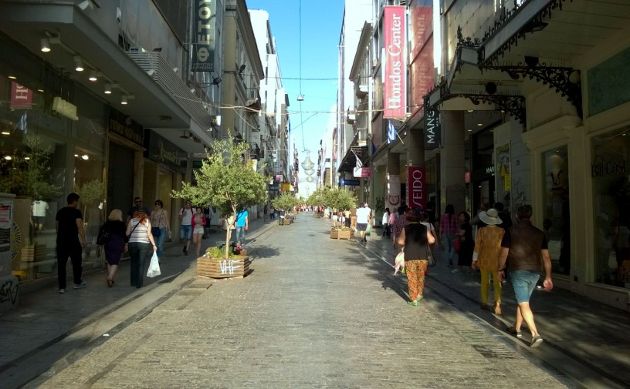-
 Podcast - Tax cuts and balancing acts: Greece's 2026 budget
Podcast - Tax cuts and balancing acts: Greece's 2026 budget
-
 Podcast - Main character energy: Greece vies for leading fossil fuel role
Podcast - Main character energy: Greece vies for leading fossil fuel role
-
 15% Uncertainty: Greece, Europe and the tariff shockwave
15% Uncertainty: Greece, Europe and the tariff shockwave
-
 Summit of transactions – Erdogan and Trump
Summit of transactions – Erdogan and Trump
-
 Podcast - DETH and taxes: The only things certain in Greek politics
Podcast - DETH and taxes: The only things certain in Greek politics
-
 How will Trump's tariffs affect Greece?
How will Trump's tariffs affect Greece?
Broad impact of inflation crisis becoming clearer

It is becoming increasingly evident to the Greek authorities that inflation is the most difficult challenge they will face over the coming months as a varied range of recent data reflects the pressure on prices and the wider economic implications.
This week, Eurostat released the latest HICP data, which saw the Greek number climb to 10.7 pct in May, from 9.1 pct in the previous month. HICP is usually one percentage point lower than the national CPI, which is monitored by ELSTAT and is due to be released on June 9.
The latest CPI figure for April was 10.2 pct, which suggests that next week’s number could be nearing 12 pct, placing the prices growth at levels that have various economic and political implications.
The producer price index in industry, which is what suppliers are charging their clients for products, is breaking one record after the other, rising by 48.8 pct annually in April, from 46.2 pct in April.
The index moved up by 2.5 pct month-on-month, from a 10.6 pct monthly movement in March, reaching 155.41 points, from 102.63 points in February last year.
Goods sold domestically rose by 48.1 pct, while those sold abroad increased by 50.9 pct.
In the broader categories in the overall market, energy products were up by 90.3 percent YoY, intermediate goods increased by 15.7 percent, capital goods were up by 10.8 percent, non-durables up by 4.8 percent and durable consumer goods increased by 3.1 percent.
The effects of the rise in the prices of inputs, which manufacturers have started shifting onto their customers via selling prices, are evident in the latest PMI release that hit the lowest in over a year at 53.8, down by 1 point, although still in expansion territory.
The overall growth in Greek manufacturing was weighed down by subdued growth in output and unchanged new orders. Both domestic and foreign demand were affected by the soaring prices, whose rise is ongoing.
Producers attribute price hikes to soaring fuel, energy, and material costs, most notably in metals and plastics.
Analysts from S&P Global, which releases the PMI data, noted that “price pressures remained substantial and continued to make inroads into client demand as customers baulked at soaring selling prices. New order inflows were broadly unchanged on the month, while there was only a marginal expansion in export business”.
Even retail sales, which have been on a solid growth streak since April last year, begin to capture on volume numbers and the monthly movements the effects of inflation.
The retail sales index grew by 20.2 pct in March, as it still benefits from the base effect of subdued sales last year as Greece was about to exit its second period of restrictions. The volume index was up 12.3 pct.
The effect of prices is most prominent in automotive fuel sales, which were up by 45.5 pct annually, however volumes increased by just 12.7 pct year-on-year. Volumes of fuel month-on-month were down by 3 pct as Greeks must contend with prices at the pump of up to 2.3 euros/litre for the basic unleaded petrol.
The social pressure generated by the price hikes have been regularly captured by the opinion polls since the start of the year and the level of dissatisfaction has grown each month.
A recent poll by Alco for Open TV indicated that a combined 59 pct of the respondents have reduced the consumption of basic goods, 17 pct said significantly and 42 pct said quite a lot.
This is causing serious issues for the authorities as after two years of support measures linked to the pandemic (totalling 43 billion euros), most of the public (68 pct) is of the opinion in the same survey that there is space for more support.
The latest relief package announced by the government was met with scepticism as 31 pct in the survey said it is not helpful at all, while 35 pct said that it only provides a little help.
This is the public’s view despite government officials repeating that all available fiscal space up to now has been used up, although leaving a little margin for optimism that more will become available thanks to bumper tourism season and the good performance of tax revenues.
Despite its downward revision, the growth forecast of 3.1 pct for 2022 relies on private consumption growing by 2.4 pct this year and investments are expected to rise by close to 10 pct.
This is based on a revised upwards HICP of 5.6 pct and in the sensitivity analysis the scenario of higher inflation by 2 percentage points in the current year, consumption is seen lower by 1 percentage point and investment down by 2.2 points, leading to a real GDP deviation from the baseline estimate of 1 percentage.
It is becoming increasingly evident that unless tourism can absorb much of the pressure on other components, inflation will have an impact on the economic outcome of 2022.
*This article appeared in last week's edition of our weekly newsletter, which is available only to subscribers. More information about subscriptions is available here.